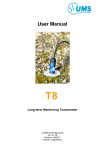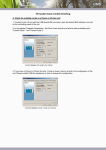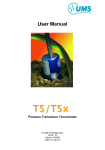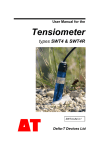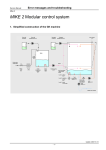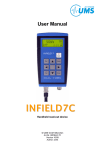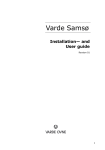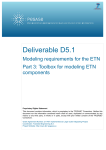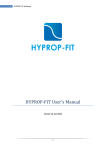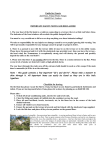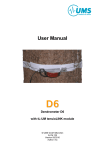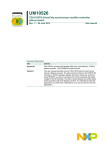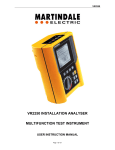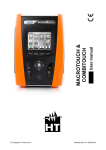Download User Manual - Decagon Devices
Transcript
User Manual T8 Long-term Monitoring Tensiometer © UMS GmbH München Art. no. T8 Revision: 072009 Authors: an/ge/tk/ma Tensiometer T8 Table of content 1 Tensiometer T8 1.1 1.2 1.3 1.4 1.5 1.6 1.6.1 1.6.2 1.7 2 Safety instructions and warnings Content of delivery Foreword Guarantee Durability Tensiometer T8 Soils and soil water Intended use Quick start guide Description of the T8 2.1 2.1.1 2.1.2 2.1.3 2.1.4 2.1.5 2.1.6 2.2 2.2.1 2.2.2 2.3 2.3.1 2.3.2 2.4 2.4.1 2.5 3 4 10 T8 parts Body and shaft Pressure sensor Reference air pressure Temperature sensor Filling status indicator The ceramic cup Output signals Analog Digital Serial interfaces ® tensioLINK SDI12 Software tensioVIEW Sensor logging 10 10 10 10 10 11 11 12 12 12 12 13 13 14 14 14 Installation 3.1 3.1.1 3.1.2 3.1.3 3.1.4 3.1.5 3.1.6 3.1.7 3.2 3.2.1 3.2.2 3.3 3.4 3.5 3.5.1 3.5.2 3.5.3 3.5.4 4 5 5 5 6 6 6 6 7 15 Concept planning and installation Selecting the measuring site Number of Tensiometers per level Extension of the site Length and solar protection of refilling tubes Jacket tubes Ideal conditions for installation Documentation Selecting the installation angle "Vertical" with downwards angle "Horizontal" with upwards angle Installation procedure Offset correction for non horizontal installations Connecting T8 Spot reading with the INFIELD7 handheld Connection to a data logger Error caused by single-ended connection Connecting the indicator 2/56 15 15 15 15 16 17 17 17 17 18 18 18 21 22 22 22 23 23 Tensiometer T8 4 T8 configuration with tensioVIEW® ® 4.1 tensioLINK USB converter 4.2 Work with tensioVIEW 4.2.1 Menu 4.2.2 Current readings 4.2.3 Stored readings 4.2.4 Configuration of a device 4.3 Configuration settings for T8 5 24 24 24 26 26 26 26 Service and maintenance 33 5.1 Refilling 5.1.1 When do Tensiometers need to be refilled? 5.1.2 Refilling in the lab 5.1.3 Refilling in the field 5.1.4 Refilling with a vacuum pump 5.2 Testing 5.2.1 Calibration 5.2.2 Check the Offset 6 Protecting the measuring site 6.1 6.2 6.3 6.3.1 6.3.2 6.4 7 Theft and vandalism Cable protection Frost Protection against frost Emptying the T8 Lightning protection and grounding Useful notes 7.1 7.2 7.3 7.4 7.5 24 33 33 34 35 37 39 39 39 40 40 40 40 40 41 41 43 Maximum measuring range and data interpretation Temperature influences Vapor pressure influence on pF/WC Osmotic effect Using a T8 as a piezometer 43 45 45 45 46 8 Troubleshooting 46 9 Appendix 47 9.1 9.2 9.3 9.3.1 9.3.2 9.3.3 9.3.4 9.3.5 9.4 Technical specifications Wiring configuration Accessories Connecting and extension cables Handheld measuring device Tensiometer augers Refill kits tensioLINK accessories Units for soil water and matriy potentials Your addressee at UMS 47 48 50 50 51 51 52 52 53 56 3/56 Tensiometer T8 1 Tensiometer T8 1.1 Safety instructions and warnings Electrical installations must comply with the safety and EMC requirements of the country in which the system is to be used. Please note that any damages caused by handling errors are out of our control and therefore are not covered by guarantee. Tensiometers are instruments for measuring the soil water tension, soil water pressure and soil temperature and are designed for this purpose only. Please pay attention to the following possible causes of risk: Lightning: Long cables act as antennas and might conduct surge voltage in case of lightning stroke – this might damage sensors and instruments. Frost: Tensiometers are filled with water and therefore are sensitive to frost! Protect Tensiometers from frost at any time. Never leave Tensiometers over night inside a cabin or car when freezing temperatures might occur! Tensiometers normally are not damaged when the cup is installed in a frost free soil horizon (in general below 20 cm). Excess pressure: The maximum non destructive pressure is 300 kPa = 3 bar = 3000 hPa. Higher pressure, which might occur for example during insertion in wet clayey soils or during refilling and reassembling, will destroy the pressure sensor! Electronic installation: Any electrical installations should only be executed by qualified personnel. Ceramic cup: Do not touch the cup with your fingers. Grease, sweat or soap residues will influence the ceramic's hydrophilic performance. 4/56 Tensiometer T8 1.2 Content of delivery The delivery of a T8 includes: Tensiometer, calibrated and filled, with 8-pin plug M12/IP67, with plug cap This manual Plastic bottle protecting the ceramic cup (must be filled to half with water to keep the cup wet) Rubber shaft water protection disk Calibration certificate with each order for conversion of electrical to physical values Refilling syringe For available accessories see chapter “Accessories”. 1.3 Foreword Measuring systems must be reliable and durable and should require a minimum of maintenance to achieve target-oriented results and keep the servicing low. Moreover, the success of any technical system is directly depending on a correct operation. At the beginning of a measuring task or research project the target, all effective values and the surrounding conditions must be defined. This leads to the demands for the scientific and technical project management which describes all quality related processes and decides on the used methods, the technical and measurement tools, the verification of the results and the modeling. The continuously optimized correlation of all segments and its quality assurance are finally decisive for the success of a project. We wish you good success with your projects. Please do not hesitate to contact us for further support and information. Yours, Georg von Unold 1.4 Guarantee UMS gives a guarantee of 12 months against defects in manufacture or materials used. The guarantee does not cover damage through misuse or inexpert servicing or circumstances beyond our control. 5/56 Tensiometer T8 The guarantee includes substitution or repair and package but excludes shipping expenses. Please contact UMS or our representative before returning equipment. Place of fulfillment is Munich, Gmunder Str. 37! 1.5 Durability The nominal lifespan for outdoor usage is 10 years, but protection against UV-radiation and frost as well as proper and careful usage substantially extends the lifespan. 1.6 1.6.1 Tensiometer T8 Soils and soil water All water movements in soils are directly depending on the soil water tension as water - in soils as well as on the surface - always will move from a point of higher potential to a point of lower potential. The majority of soil water flows take place at small water tensions. Only Tensiometers allow the direct and precise measurement of these small tensions. Naturally embedded soils are heterogeneous. Not only precipitation and evaporation effect the processes, but also texture, particle size distribution, cracks, compaction, roots and cavities. Due to these heterogeneities the soil water tension varies. Thus, it is reasonable to have multiple measuring points at least in soil horizons close to the surface. 1.6.2 Intended use The intended use of tensiometers is the measurement of soil water tension respectively of matrix potential. These tensiometers work from +100 kPa (water pressure) to -85 kPa (suction / soil water tension). If the soil gets drier than -85 kPa, the Tensiometer runs dry and must be refilled as soon as the soil is sufficiently moist again (see chapter 5.1). Soil water and Tensiometer water have contact through the ceramic which is porous and permeable to water. A wetted porous ceramic creates an ideal pore/water interface. The soil water tension is directly conducted to the pressure transducer which offers a continuous signal. The atmospheric reference pressure is provided through a membrane on the cable, a distinctive patented method. 6/56 Tensiometer T8 1.7 Quick start guide This chapter is only a summary of following chapters. Please read the complete manual carefully before using the instrument. In general, the T8 is filled and ready for installation when supplied. 1. Drilling the borehole: Mark the required drilling depth on auger and on Tensiometer shaft. Note: Installation depth = drilling depth / cos . For installation from the soil surface, an installation angle of 25° to 65° from the vertical line is ideal for the optimal removal of air from the cup (fig. a). For “horizontal” installation from a manhole the borehole should point upwards in an angel of 5° (fig. b). 2. Slurrying the cup is only recommendable in clayey soils and only if the bore hole is larger than 24 mm. In coarse sand or pebbly soils fine pored slurry might create a water reservoir which slows down the response. With the special Tensiometer gouge auger (article no. TB-25) slurrying is unnecessary because of the accurate fitting of the Tensiometer in the soil. 3. Take off the protective plastic bottle from the Tensiometer cup. Tilt and pull the bottle off carefully. If necessary, carefully turn it counterclockwise! 4. Insert the T8 into the hole to the depth mark without using force. In clayey soils a dangerous overpressure might develop: Check the tensiometer's pressure reading with an Infield measuring device or a data logger! Important: Pay attention to the engraved black spot on the shaft’s top end that marks the position of the exit opening of the external filling inside the cup: a) Downwards installation: If the position of the cup will be lower than the end of the shaft, the yellow sticker must exactly face up! (b) (a) b) Upwards installation: If the position of the cup will be higher than the end of the shaft, the yellow sticker must exactly face down! 7/56 Tensiometer T8 External syringe refilling Installed T8 can be refilled or ventilated through the two capillary tubes (stainless steel) without being removed from the soil. The tubes can be extended. With the supplied refilling syringe a measuring range of at least -80 kPa can be assured. With the special Refilling Kit BKT456 a range of -85 kPa can be assured. Reference air pressure The reference atmospheric air pressure is conducted to the pressure transducer via the water impermeable (white) Teflon membrane and through the cable. The membrane must always have contact to the air and should never be submersed into water. Optional protective plastic tube Available as accessory Cable gland (IP67) The T8 can be completely buried if required. Cables and tubes of buried T8 should be protected. Special cable glands are available for tight connection of a Shaft One-piece shafts from 10 cm to 200 cm are available. Shafts over 200 cm are divided with threaded adapter. Sensor body incl. electronics Direct connection between internal power converter to 6-18 VDC Pressure sensor The piezoelectric pressure sensor measures the soil water tension against atmospheric pressure Temperature and level indicator High grade porous ceramic cup Filled with degassed water. 8/56 Tensiometer T8 5. Push down the shaft water retaining disk to a position directly on the soil surface. 6. Slide on the thermal insulation tube over the capillary filling tubes. 7. If the plug is not connected right away leave the protective cap on the plug. Water tightness is only assured when the plug is kept clean. 8. Connect the Tensiometer signal wires as specified (see chapter „Connecting the T8”) The T8 can be connected to: data loggers with analog input or serial RS485 or SDI12, a PC or laptop via tensioLINK bus as a standalone sensor or within a sensor network, an additional 6 V Battery to run the T8 in the auto-logging function (internal data logger, requires tensioVIEW software and USB converter for configuration), the INFIELD7 for taking spot readings or downloading stored readings. Please note: Especially in loamy, clayey soils a high pressure can occur just by inserting the T8 into the borehole. Thus, the pressure values should be continuously observed during installation, either with the INFIELD7 handheld or online with laptop, USB Converter and tensioVIEW. Note for the latter that the readings are refreshed only every 5 seconds by the internal microprocessor. The less air is inside the cup and the better the soil's conductivity is, the faster the Tensiometer will respond to tension changes. If the soil is dryer than -90 kPa, it does not make sense to refill the Tensiometer. The refilling procedure will be done best at the time when the Tensiometer installed in the next lower level has reached the value of drying off of the upper Tensiometer.. 9/56 Description of the T8 2 Description of the T8 2.1 2.1.1 T8 parts Body and shaft The whole electronics are integrated in the body of the T8. The housing is made of fiberglass reinforced plastic. The electronic is completely sealed and thus well protected against moisture. 2.1.2 Pressure sensor The piezoelectric pressure sensor measures the soil water tension against the atmospheric pressure. The atmospheric pressure is conducted through a watertight diaphragm (the white, 2 cm long tube on the cable) and through the cable to the reference side of the pressure sensor. The non destructive maximum pressure is 3 bar (300 kPa). Higher pressure will damage the sensor and absolutely must be avoided! High pressures can appear for example when cup and sensor are reassembled, when inserted in wet, clayey soils or in tri-axial vessels. 2.1.3 Reference air pressure The reference atmospheric air pressure is conducted to the pressure transducer via the air permeable (white) Teflon membrane and through the cable. The membrane does not absorb water. Water will not pass through the membrane into the cable, but condensed water inside the cable will leave the cable through the membrane. The white membrane on the cable must always have contact to air and should never be submersed into water. 2.1.4 Temperature sensor A temperature probe with a tolerance of 0,2 K at 10 °C is used. The tip of the temperature sensor dips into the Tensiometer cup's water. Thus, the best possible thermal contact to the soil is achieved. 10/56 Description of the T8 2.1.5 Filling status indicator The filling status indicator indicates the filling status of a T8 in a downwards installation (cup lower than end of the shaft). If the Tensiometer is installed in an upward angle (cup higher than the end of the shaft), the water will still cover the indicator even if air is already inside the cup. Thus, the indicator will react not before the cup is almost completely empty (s. fig. 5.3 on page 38). The filling status is determined by measuring the heat flux with the internal temperature probe. For a probe dipped into water the heat flux rate is lower than in air. If an air bubble appears around the temperature probe, the heat flux rate rises and the insufficient filling status is detected. This method offers a rough but reliable reference for checking the filling and has the advantage of staying stable over the whole lifespan of the Tensiometer. It replaces the previously use IR-photo diode. The measurement of the soil water tension is not influenced. Benefits of the filling status indicator are an optimal service: If for example mounting rails with integrated LEDs are used, the user can check at a glance if all Tensiometers work well or which need to be refilled. Also, for quality assurance, the status of the signal can be logged for later evaluation of the readings. 2.1.6 The ceramic cup To transfer the soil water tension as a negative pressure into the Tensiometer, a semi-permeable diaphragm is required. This must have good mechanical stability and water-permeability, but also have gas impermeability. The T8 cup consists of ceramic Al2O3 sinter material. The special manufacturing process guarantees homogeneous porosity with good water conductivity and very high firmness. Compared to conventional porous ceramic the cup is much more durable. The bubble point is at least 1500 kPa (15 bar). If the soil is dryer than 1500 kPa the negative pressure inside the cup decreases and the readings go down to 0 kPa. With these characteristics this material has outstanding suitability to work as the semi permeable diaphragm for Tensiometers. The cup has a lifetime guarantee against breakage. 11/56 Description of the T8 2.2 2.2.1 Output signals Analog The T8 version 2005 has an internal microprocessor and offers water tension and temperature as analog output signals plus the refilling status as a digital signal. Water tension and temperature are available as linear voltage signals in a selectable range of 0...1 V, 0...2 V (default setting) or 0...5 V. Thus, the T8 are compatible to almost any data logger or data acquisition system. Furthermore, the measuring range itself can be set for special measuring tasks. Standard is +100 kPa to -100 kPa and -30 to +70°C. The standard setting for the filling status is either switch “open” (0 V) or “closed” (voltage signal equal to power supply voltage). 2.2.2 Digital To change the settings of signal range or use the serial interface of the T8 the tensioLINK® USB converter with Windows software tensioVIEW® is available as an accessory. Filling status as a Digital Status If the indicator detects an air bubble the indicator switch closes and the supply voltage is available on the output. If for example a LED with a series resistor is connected, the LED will light up to indicate the necessity of refilling. In addition, or instead, connect the signal to a digital or analogue logger channel to record the filling status for quality control of the matrix potential readings. 2.3 Serial interfaces The T8 has two serial interfaces: the RS485 compatible tensioLINK interface and SDI12. 12/56 Description of the T8 2.3.1 tensioLINK® To use the serial interface the tensioLINK® USB converter with Windows software tensioVIEW® is required. tensioLINK® is RS485 based and used for all functions, for taking online readings, for uploading stored data and for configuration of the T8. RS485 allows a robust and cost effective bus linkage of sensors with cables of up to a few kilometers. Data loggers with RS485 interface can directly read sensors. Please contact UMS for a description of the data protocol. 2.3.2 SDI12 Additionally a SDI12 interface is integrated for connection to SDI12 systems. The SDI12 interface has to be activated via tensioVIEW®. Then, one of the 2 analog outputs is used as the SDI12 data line. 13/56 Description of the T8 2.4 2.4.1 Software tensioVIEW The Windows software tensioVIEW® (supplied with the tensioLINKUSB converter) automatically detects all tensioLINK devices linked within a bus network. The software is used for the configuration of these devices and for displaying data. tensioVIEW® shows for example the settings of a VS vacuum station or T8 readings from the recent days. When used in a laboratory no other device is required beside tensioLINK, tensioVIEW and PC to have a complete data acquisition system. Readings are displayed and stored by the PC directly. 2.5 Sensor logging UMS Tensiometer T8 and TS1 have an internal non-volatile data memory. When connected to a power supply readings of soil water tension and soil temperature are taken and stored in selectable intervals of 1 minute to 24 hours. The T8 has a capacity of 4000 readings which, with an interval of 1 hours, is enough for 166 days of measurements. In this mode of operation the power consumption is very low, so modest battery capacities are sufficient even for long measuring periods. To run stand-alone sensors a battery box is available as an accessory. The weatherproof box is fitted with a tensioLINK plug for uploading the data stored in the sensor. 14/56 Installation 3 Installation 3.1 Concept planning and installation 3.1.1 Selecting the measuring site The installation spot should be representative for the soil horizon! Therefore, in heterogenic soils, classifying drillings should be made before or during installation. On farmed sites with vegetation root spreading and root growth during the measuring period must be considered. Fine roots will grow around the Tensiometer cup as this is a poor but still secure source of water. Therefore, avoid the root zone or move the Tensiometer from time to time depending on the root growth. Disturbing effects like waysides, the rim of a field, slopes or dints must be avoided or considered in the interpretation of the measuring results. 3.1.2 Number of Tensiometers per level The lower the level the less the variations of water potentials are. In sandy or pebbly profundities one Tensiometer per depth is sufficient. Close to the surface about 3 Tensiometers per level are recommendable. Guiding principle: More heterogeneous sites and soil structures require a higher number of Tensiometers. 3.1.3 Extension of the site Large distance along with high equidistance between the measuring spots will reduce the influence of sectional heterogeneity. To obtain a differential description of the soil water situation at least 2 Tensiometers are recommended per horizon, one in the upper and one in the lower level. Cable lengths of 100 meters and more are possible (see chapter 8.2 for cables) but should be avoided for the following reasons: Accuracy: with a single-ended connection each 10 meter of cable causes a reduction of the accuracy. (See chapter 3.3.1 for compensation of current drop with single-ended connections) 15/56 Installation Lightning: cables act as antennas and should always be as short as possible. 3.1.4 Protection of refilling tubes A recent study by Prof. Wolfgang Durner showed that refilling tubes must be protected from heating up and solar radiation. If a bubble assembles inside a refilling tube, temperature changes will lead to an expansion of the air resulting in a variation of the reading. Therefore, refilling tubes should be as short as possible and should be thermally protected, either by providing an insulating protection or by burying the tubes. Thermal effect: As long as the Tensiometer and its tubes are freshly and completely filled it will work perfectly. Any air trapped inside the upper parts of the tube will expand when heated up by solar energy. This causes a drop of the water tension and some water will flow from the cup into the ground. Thus, readings will fluctuate around the actual reading during solar radiation, especially with low water potentials. Furthermore, under permanent solar exposure the tubes get sticky and brownish. Slide the supplied thermal insulation tube over the shaft end and the refilling tubes as shown in above photo! 16/56 Installation 3.1.5 Jacket tubes Jacket tubes are useful with shafts longer than 2 m, in pebbly soils or gravel, and for horizontal installations from inside a well or pit hole. The jacket tube should end 30 to 50 cm away from the cup so leaking or condensation water is not conducted to the cup. The inner diameter of the jacket tube should be at least 35 mm. 3.1.6 Ideal conditions for installation For the installation of Tensiometers, the ideal conditions are: Frost-free soil. Wet coarse clay or loess. Low skeletal structure (gravel). The more gravel in a soil the more often the drilling has to be repeated to reach the required depth. 3.1.7 Documentation For every measuring spot you should: Measure out the position where the pressure sensor will be placed. (A must for installations below the ground surface). Take documenting photos before, during and after installation. Save a soil sample. Write down installation depth and angle with the sensor identification (serial number). Mark all connecting cables with the corresponding sensor identification, serial number or logger channel on each end. Clipon number rings are available as an accessory (see chapter 9.2). 3.2 Selecting the installation angle An installation position would be ideal if the typical water flow is not disturbed by the Tensiometer. No preferential water flow along the shaft should be created. Therefore, Tensiometers are preferably installed at an angle. 17/56 Installation 3.2.1 .2.1 "Vertical" with downwards angle When installed from the surface, an angle of 25° to 65° from the vertical is optimal for refilling. In an absolutely vertical position air bubbles might inside the edges of the cup adapter. Still, they could be removed completely with the vacuum refilling kit BKTex. In this position, the refilling tube is the shorter stainless steel tube with the yellow sticker. Into this tube, water is injected for refilling. Before inserting the Tensiometer, turn the shaft so the yellow sticker near the shaft end points upwards. Do not turn the shaft after it is inserted into the ground as this might loosen the cup. 3.2.2 "Horizontal" or upwards installation angle When installed horizontally or upwards from inside a well or pit hole, the shaftmark must look downwards! An upward angle of approx. 5° is ideal for refilling. Note that now de-airing and refilling tube are switched: the refilling tube is the longer stainless steel tube without the black mark. Into this tube, water is injected for refilling. Before inserting the Tensiometer, turn the shaft so the yellow sticker near the shaft end points downwards. Do not turn the shaft after it is inserted into the ground as this might loosen the cup. Note that with a horizontal installation the filling indicator will not react much later, - if installed upwards not before until the cup is almost empty. 3.3 Installation procedure For the installation of the T8 in the field the following tools are required: Tensiometer auger with diameter 25 mm, ideally the UMS gouge auger with shaped blade tip. Rule, spirit level, angle gauge, marker pen. Minute book, camera for documentation of site and soil profile. 18/56 Installation Perhaps PE-plastic bags for taking soil samples from the site. Thermal insulation tubes for installations from soil surface. Cable protection tubes. Jacket tubes if required (inner diameter > 35 mm). Please observe the following notes: Do not touch the cup with your fingers. The ceramic should not have contact with grease or soap as this will influence the hydrophilic performance. Do not leave the cup in air for more than 5 minutes as Tensiometer water will evaporate and the Tensiometer will need to be refilled. Procedure: 1. Mark the required drilling depth on auger and Tensiometer shaft. The reference point is the center of the cup. Drill a hole with the desired depth on the chosen measuring spot. Auger stepwise and take care when drilling the last 20 cm, remove and save this soil. Water will not run along the shaft if the Tensiometer is installed in an angle because the water will drain into the soil before it reaches the cup. Read the chapter "Selecting the installation position" for the best installation angle. 2. When using augers with a diameter of over 25 mm, mix a paste of water and crumbled soil material taken out of the borehole. Fill the paste into the bottom area of the borehole by using a simple pipe with outer diameter 2 cm. 3. Now take off the protective plastic cap from the Tensiometer cup. Important: Do not turn, but pull when taking the bottle off - and also when putting it back on again! Save the plastic bottles: Do not store the Tensiometer without the protective plastic bottle since the cup drains fast! The bottle must be filled with some water for storage! 19/56 Installation 4. Connect the Tensiometer to a readout unit. Check the position of the yellow sticker. Carefully insert the T8 into the borehole up to the stop while continuously observing the pressure signal. Using the TB25 auger you feel a light resistance at the last 6 cm indicating proper soil contact of the ceramic. Do not use any force. Do not hit the Tensiometer - this may damage cup and pressure sensor. Especially in clayey soils the pressure reading must be monitored as high pressures might build up! The pressure must not exceed 200 kPa 5. Press the soil surface with your boots gently to the shaft to close the gap. 6. Push the shaft water retaining disk down to cover the soil surface. This prevents water from running down into the borehole along the shaft. 7. Leave the protective plastic cap on the plug whenever the plug is not connected! 8. Connect the signal cables as described in the chapter "Connecting the T8". 9. The Tensiometer will respond to changes in the soil water tension faster if there is no air inside the system and the soil water conductivity is high. 10. Write down the serial number, position, installation angle and depth. 11. Slide the supplied thermal insulation tube over the shaft end and the refilling tubes. Bend the signal cable and lead it back through the thermal tube. 12. Protect the cables against rodent bites. Lead the cables through plastic pipes or use the plastic protection tubes which are available as an accessory. 20/56 Installation 3.4 Offset correction for non horizontal installations The pressure transducer is calibrated without a cup. Thus, no compensation is required for horizontal installations. If a T8 is installed in a non horizontal position, the vertical water column draws on 5cm the pressure sensor and causes an offset shift. Compensate the offset: Middle of cup by calculation, by entering the installation angle in the Infield7 for spot readings, in the configuration of a data logger by setting an offset, by storing the installation angle directly inside the installed T8 through the tensioLINK interface. Transducer The middle of the cup is regarded to be the measuring level. The o correction is largest for a vertical water column (at 0 ) and varies as the cosine of the installation angle, as shown on the table below. In an absolutely horizontal position the offset is zero. Example: A 5 cm vertical column of water below the pressure sensor will create an 0.5 kPa offset. This means that when the soil water tension is 0 kPa the sensor will indicate -0.5 kPa. Table showing the offset correction when a 5 cm column of water is tilted at various angles: Angle to vertical line Offset correction in [kPa] Angle to vertical line Offset correction in [kPa] 0° 10° 15° 20° 25° 30° +0,5 +0,49 +0,48 +0,47 +0,45 +0,43 45° 60° 70° 75° 80° 90° +0,35 +0,25 +1,7 +1,3 +0,9 0 The offset is entered as + in your logger if you regard the soil water tension to be negative (0 ... -85 kPa). 21/56 Installation 3.5 3.5.1 Connecting T8 Spot reading with the INFIELD7 handheld The T8 is fitted with an 8-pin plug. The plug can be connected to an INFIELD7 handheld measuring device. The INFIELD7 displays and stores the soil water tension, the soil temperature and the filling status. 3.5.2 Connection to a data logger For connecting T8 to a data logger or any other data acquisition devices connecting and extension cables are required. Find T8 cables in the chapter “Accessories”. The supply voltage does not has to be stabilized. If the Tensiometer is not permanently powered the warm-up before a measurement should be at least 10 seconds. The Tensiometer plug should be covered with the supplied protective cap anytime the T8 is not connected to an extension cable. Never connect the signal outputs of the T8 to a supply voltage source! The supply voltage must not exceed 18 VDC. Tightly screw together all plugs of connecting cables (CC-8/...) or extension cables (EC-8/...). Do this again after a few minutes as only then the connections will be absolutely water proof. 22/56 Installation 3.5.3 Error caused by single-ended connection In general a data logger with differential inputs should be preferred. This means both the plus signal as well as the minus signal of each sensor are measured. On many data loggers less channels are required for single-ended measurements, which means only the plus signals are measured and related to the common sensor supply ground. In this case, the voltage drop, depending on the current consumption and the cable resistance, influences the reading and must be compensated for: Example: Current consumption 3 mA; cable resistance: 0,082 /m (for UMS standard cable and signal range 0 ... 2 V) Voltage drop inside a cable with length 10 m: UError/10m cable = R x I = 0,82 x 3 mA = 2,5 mV Error for water tension (1 mV equal to 0,1 kPa): 2,5 mV = 0,25 kPa Error for temperature (1°C equal to 20 mV): 2,50 mV = 0,25 K Thus, the signal is lifted for +0,25 kPa and +0,1 K per 10 m cable. With the standard signal range 0...2 V the readings will be: for 100 kPa = 2,5 mV and -30°C = 2,5 mV (instead of 0 mV) for -100 kPa = 2002,5 mV and +70°C = 2002,5 mV (instead of 2000 mV). Change the offset correction in the data logger accordingly. The signal gradient (conversion factor) is not changed by the voltage drop. 3.5.4 Connecting the indicator Some data logger types require a pull-down resistor (for example 10 kOhm) against ground for the indicator (Pull down resistor). The external pull-down resistor must be smaller than the logger internal pull-up resistor, or at least be in a relation so the logger will recognize the zero level. Please contact UMS if you have questions regarding the indicator connection. 23/56 T8 configuration with tensioVIEW® 4 T8 configuration with tensioVIEW® 4.1 tensioLINK® USB converter The power supply of the tensioLINK® converter is galvanically isolated from the PC or Laptop and can be used to power connected sensors. The 8-pin T8 plug has the standard tensioLINK® plug configuration and can be directly connected to the converter without the need of any further items. Bus distribution modules are available to link numerous sensors. Any custom made cables require 4 wires for a parallel connection of all sensors. If sensors should be supplied by another power source take notice to avoid potential differences. This can be achieved by connecting the GND of both power sources. The V+ line of the USB converter then is not used. 4.2 4.2.1 Work with tensioVIEW Menu tensioVIEW® has a simple menu for mostly self-explaining read-out and configuration of tensioLINK devices. After starting tensioVIEW the display is more or less blank, most functions are inactivated. Search devices If one or more sensors are connected via the USB-converter they can be searched by pressing the “magnifier” button. tensioVIEW® offers two options for searching: Single device mode tensioVIEW® expects that only one device is connected which will be found very quick. This mode is not functional if more than one device is connected! Multiplex device modes tensioVIEW® is able to detect up to 256 devices connected to the bus within 8 seconds, but only if each device is already personalized 24/56 T8 configuration with tensioVIEW® with an individual bus identification address. If two or more devices have an identical address, none of them will be found. All devices found will be displayed in the left section as a directory tree. Same types of devices will be grouped in one directory. Ordner für Geräte eines Typs Gerät Fig. 4.1: Found devices in tensioVIEW Detected devices will be displayed with their programmed names. Press the + symbol to see what readings the device can offer. Double-click on the name to open a menu window where all specifications and functions of this device are displayed. Depending on the type different registries are available. The first shows an overview of the current settings and information about address number or error messages. 25/56 T8 configuration with tensioVIEW® 4.2.2 Current readings Enter the interval parameters and press ”Start” to display the current readings. 4.2.3 Stored readings Open the menu “Stored readings“ to upload the data from a T8 (if logging had been activated in the logger menu) 4.2.4 Configuration of a device Select the register "Configuration“ for viewing and changing the programmed settings of the device. Depending on the authorization status, only parameters that can be edited are shown. To store it in the device. a changed parameter has to be sent to the device by pressing the "Upload“ button. A message notifying about the successful configuration will be displayed. Configuration changes are effective immediately. Tensiometers for example will re-start just as if they were connected to power. 4.3 Configuration settings for T8 Those settings which are editable only for Power users are marked with an asterisk *. Parameters with related functions are bundled in one folder. 26/56 T8 configuration with tensioVIEW® Figure 4.2: Configuration menu tensioLINK Bus number tensioLINK bus number of the device Sub address tensioLINK sub address of the device Explanation: tensioLINK uses two types of address for each device, the bus address and the sub address. The reason for this is that is there might be sensors installed at the same spot, but with different measuring depths (for example multi-level probes). In this case, the sub address defines the depth starting with 1 for the highest sensor. Furthermore, the sub address could be used to combine groups of sensors, for example of one measuring site. In general the required identification for a device is always the bus number. If more than 32 devices are connected to the bus the sub address is counted up. The allowed numbers for the bus address are 1 to 32 and for the sub address 1 to 8. 27/56 T8 configuration with tensioVIEW® The default value for both bus and sub address is 0. With more than one device connected individual addresses have to be declared. Serial interface activated during power down* Serial reception possible in sleep mode. When data are received thorough the RS485 interface the TS1 is wakened, With an activated reception the TS1 consumes approximately an additional 0.5 mA. Device information Device name Individually editable name of the Tensiometer in ASCII. Maximum length 12 digits Calibration date Date of the last calibration. In general sensors should be recalibrated and checked after two years. Installation depth Here the installation depth can be entered. This is for your information only and has no further functions. Installation angle Installation angle selectable from 0° to 180°. If activated the water column inside the ceramic cup will be compensated in relation to the installation angel. (0° means the Tensiometer is installed vertically). Soil type Type of soil at the installation site: Only for information, does not influence the Tensiometer readings. Ceramic Type* For special ceramics for compensation of the installation angle only. Compensation length Effective length of the total water column in [0.1 cm] for compensation of the installation angle. Data logger Interval Logging interval of the internal logger Ring buffer memory With ring buffer activated the oldest readings are overwritten when the memory space is full. 28/56 T8 configuration with tensioVIEW® System The Power Save Mode puts the Tensiometer to sleep when inactive. Analog outputs are then switched off and the current consumption is significantly reduced. If data is read out only serially, or the internal data logger is used, activate this option without reducing the Tensiometer operation. Possibly the Tensiometer will react a little bit slower to serial commands. Sensor readings Continuous measurements Activate the quick updating of readings to receive the Tensiometer readings instantly, for example during a refilling procedure. Measurements are taken in intervals of 50 ms. Note the rise in power consumption and that the reaction to serial commands might be slowed down. The setting "Measuring interval“ is deactivated during this mode.. Measuring interval This is the standard interval in which sensor measurements are refreshed and available on the analog lines. 29/56 T8 configuration with tensioVIEW® Figure 4.4: Configuration menu: sensor measurements Analog Outputs (DAC) DACA active Turns on the analog output 1 (standard use pressure) DACB active Turns on the analog output 2 (standard use temperature) Associate reading DACA A sensor reading can be associated to analog output 1. Standard for analog output 1 is pressure. Associate reading DACB A sensor reading can be associated to analog output 2. Standard for analog output 2 is temperature. Associate depth DACA For multilevel probes the DACA reading can be associated to a certain depth. Then, tensioLINK will take readings using the same bus address plus the sub address. For the default value depth = 1 the internal sensor readings are used. 30/56 T8 configuration with tensioVIEW® Associate depth DACB Associate a depth to reading DACB. DAC error output Error output value for DAC [mV]. If an incorrect reading occurs (e. g. filling status insufficient) this voltage value will be put on the analog output. DAC output range Set the output range of the analog reading to 0 to 1 V; 0 to 2 V or 0 to 5 V. A sensor reading will be amplified within this range, for example -100 kPa to +100 kPa can correspond to 0 to 2 V. DAC temperature output range Output range for temperature. DAC pressure output range Output range for pressure. Digital output Digital output power saving Activate the power saving function of the digital output. Any burden connected to the digital output will be powered shortly every 5 seconds (e. g. a LED will blink every 5 s indicating a malfunction) Function of the digital output Evaluation through a table. If the digital output is used for control of the filling status, 1 indicates a poor filling status. If used as a comparator the value of a reading is compared to the set threshold (see "Lower threshold"). If used as a window comparator the reading is compared with both threshold values. In case the reading is in between both threshold values the digital output is set to 1. Associate reading to digital output This is the relevant reading for the comparator. Associate depth to digital output The depth value for comparator, 1 = individual sensor (see "Associate depth DACA“) Invert digital output function If enabled all digital output functions will be inverted. Lower threshold integer Integer part of the lower threshold or window threshold value. Upper threshold integer Integer part of the upper window threshold. 31/56 T8 configuration with tensioVIEW® Lower threshold decimal Decimal part of the lower threshold or window threshold. Upper threshold decimal Decimal part of the upper threshold or window threshold. Configuration example for the digital output: Function of the digital output = comparator Associated reading on digital output = temperature Integer part of the lower threshold = 24 Decimal part of the lower threshold = 3 if temperature is higher than 24.3° the digital output is set to 1. Filling status testing Measuring interval Interval in which the filling status is checked with the Thermistor (BDT) method. 32/56 Service and maintenance 5 Service and maintenance 5.1 Refilling To assure a rapid and reliable measurement of the soil water tension, the cup must be filled possibly bubble-free with degassed water. After dry periods or periods with a large number of wet and drying out successions, the T8 must be refilled. The following items are required for all refilling methods: Syringe with valve (one supplied with each order) Degassed, de-ionized or distilled water Measuring device for checking the pressure signal Simple method to degas water: The best way to degas water is by using a syringe. Draw up water into the syringe until it is 2/3 filled. Close the valve or block the syringe with your finger. Now draw up the syringe as far as possible to create a vacuum inside. Rotate the syringe to create one big bubble. Take of your finger or open the valve and squeeze out the bubble. Repeat this procedure a few times. 5.1.1 When do Tensiometers need to be refilled? Tensiometers need to be refilled: when the IR indicator will light up (for Tensiometers installed "downwardly"), the curve of the readings apparently gets flatter (for example a rain event has no sharp peak but is round), the maximum of -85 kPa is not reached anymore. Refilling is only reasonable if the soil is moister than -90 kPa or if a lower level installed Tensiometer shows wetter readings again If the soil gets dryer than -85 kPa, the readings will remain constant at the vapor pressure of water (i. e. for example 92,7 kPa at 20°C and atmospheric pressure of 95 kPa). By diffusion and slight leakage the reading will slowly drop within months. 33/56 Service and maintenance If the soil dries out more than -1500 kPa (-15 bar), the negative pressure will drop much faster as air will enter the cup. 5.1.2 Refilling in the lab To reach the optimal measuring range of -90 kPa Tensiometers should be refilled in the laboratory using the refill kit. 1. Set up the refilling kit and connect the vacuum pump as shown in the photo. The pump should achieve at least 0,8 kPa against vacuum. Use distilled or de-ionized water which necessarily does not have to be degassed when a pump is used. 2. Unscrew the cup in clockwise direction and empty it. Do not touch the ceramic cup with your fingers. Wrap a clean towel around the cup! The pressure sensor diaphragm is inside the small hole on the pressure sensor body. It is very sensitive and may never be touched! It can be destroyed even by slightest contact! No contamination should get on the sealing and gasket. 3. If the cup is dry it should be placed in a beaker filled with distilled water for several hours or overnight. Initially there should be no water inside the cup! Place the empty cup into the beaker in an upright position, with the external water level reaching no higher than 2/3 of the cup. If the cup is filled with water and water intrudes from both inside and outside cavities of air will be enclosed inside the ceramic. Vacuum gauge Adaptor for sensor body Adaptor for ceramic cup Connection to vacuum pump Fig. 5.1: UMS laboratory refill kit BKT468 34/56 Service and maintenance 4. Insert the saturated but empty cup to the adapter and connect it 5. 6. 7. 8. 9. 10. 5.1.3 to the degassing device. Place the cup in water in an upright position. Fill the second UMS adapter capsule to the half with water and insert the sensor body. Connect the adapter to the degassing device as well. Now start the vacuum pump. With well-saturated cups, the procedure will take 1 to 2 hours. From time to time knock on cup and sensor body to loosen bubbles. Degassing is complete when no air bubbles ascend from ceramic and body and the cup is completely filled with water. Before screwing together cup and sensor body connect the sensor to a measuring device to observe the pressure signal. Destructive pressure is 3 bar. Hold the cup in an upright position, fill it completely and with an overlapping bulge of water. Carefully and slowly screw the cup on the sensor body. Allow the excess water to escape. Make sure that no bubbles are enclosed. Fix the Tensiometer in an angle so the cup is pointing downwards, and the yellow sticker on the shaft is on top. Degas the water in the syringe as described above and connect it to the marked refilling tube. Do not bend the rubber tube. Carefully press water into the refilling tube until no bubbles come out of the de-airing tube. Fill in at least 25 ml. Check the pressure at any time! Remove the syringe and connect the rubber tube to the open refilling tube. Refilling in the field T8 Tensiometers can be refilled with the supplied 50 ml syringe through the stainless steel tubes without removing them from the soil. If the refilling tubes have a total length of 5 meters or more it might be necessary to use the hand-operated vacuum pump – see chapter 5.1.4. 35/56 Service and maintenance With this method a measuring range of at least -80 kPa can be achieved. Fig. 5.2 Downwards installation – the marked tube is the refilling tube, the unmarked tube the de-airing tube Fig. 5.3 Upwards installation – the marked tube is the de-airing tube, the unmarked tube the refilling tube Procedure (see fig. 5.2 & 5.3): 36/56 Service and maintenance 1. Connect the T8 to the measuring device and keep an eye on the pressure signal at any time. 2. Two steel capillary tubes come out from the T8 shaft: The refilling tube and the de-airing tube. In a downwards installation the marked tube is the refilling tube, in an upwards installation the not marked tube is the refilling tube. Pull off the rubber tube from the refilling tube. 3. Connect the tube of the syringe to the refilling tube. 4. Carefully inject water into the refilling tube until no bubbles come out of the de-airing tube. Fill in at least 25 ml. Check the pressure at any time! 5. Remove the syringe. Put a drop of water on both rubber and steel tube's end. Connect both. 5.1.4 Refilling with a vacuum pump To achieve the maximum possible measuring range Tensiometers can be completely degassed using a vacuum pump. This method can be applied for installed Tensiometers in any installation angle as well as for not installed Tensiometers. For refilling tubes longer than 5 meter this method should always be used. The UMS refill kit BKTex includes all required tools: hand-operated vacuum pump, vacuum bottle with tube and syringe with valve. Procedure (see fig. 5.4 & 5.5): 1. Connect the T8 to the measuring device and keep an eye on the pressure signal all the time. 2. In an downwards installation the marked tube is the refilling tube. In an upwards installation the unmarked tube is the refilling tube. Pull off the rubber tube from the refilling tube. 3. Degas the water inside the syringe as described above. Connect the syringe to the refilling tube and close the valve! 4. Connect vacuum bottle and de-airing tube. With the vacuum pump evacuate the bottle to the maximum possible vacuum. This will enlarge the remaining bubble inside the cup. 5. Now briefly open and close the valve of the syringe for a few times: water is drawn into the Tensiometer while at the same time the air bubble is sucked into the vacuum bottle. Repeat this 2 or 3 times until no bubbles come out anymore. 37/56 Service and maintenance 6. Close the valve of the vacuum bottle and remove the bottle. Inject 5 ml of water from the syringe into the refilling tube. Remove the syringe. Put a drop of water on both rubber and steel tube's end. Connect both. Fig. 5.4 Downwards installation – the marked tube is the refilling tube, the unmarked tube the de-airing tube Fig. 5.5 Upwards installation – the marked tube is the de-airing tube, the unmarked tube the refilling tube 38/56 Service and maintenance 5.2 5.2.1 Testing Calibration When delivered Tensiometers are calibrated with an offset of 0 kPa (when in horizontal position) and a linear response. The offset of the pressure transducer has a minimal drift over the years. Therefore, we recommend you check sensors once a year and re-calibrate them every two years. Return the Tensiometers to us for recalibration, or use the calibration accessories available from UMS. 5.2.2 Check the Offset With zero pressure difference between inside and outside of the cup (cup in air) the signal should be 0 kPa. There are two ways to check the offset. 1. Connect the Tensiometer to a readout device. Place the filled T8 in a beaker and fill the beaker with distilled or de-ionized water to a height of 7,5 cm. Wait until the reading is stable. If there are bubbles inside the cup this might take a while. The reading now should be 0 kPa. 2. To check the zero-point more precisely unscrew the cup. Shake the pressure sensor to remove water from the pressure transducer hole. The offset is acceptable when the reading is between -0,5 and +0,5 kPa. The pressure sensor diaphragm is inside the small hole on the pressure sensor body. It is very sensitive and must never be touched! It can be destroyed even by slightest contact! No contamination should get on the sealing and gasket. Before reassembling cup and sensor body carry out the degassing procedure (see chapter 5.1.2 "Refilling in the lab"). For testing the signal gradient a calibration kit is required. 39/56 Protecting the measuring site 6 Protecting the measuring site 6.1 Theft and vandalism The site should be protected against theft and vandalism as well as against any farming or field work. Therefore, the site should be fenced and signposts could give information about the purpose of the site. 6.2 Cable protection Cables should be protected against rodents with plastic protection tubes. UMS offers dividable protection tubes as accessory. For long term studies we recommend to dig cables a few centimeters below soil surface inside protection tubes 6.3 6.3.1 Frost Protection against frost Tensiometer are filled with water and therefore are endangered by frost! Do not store filled Tensiometer at temperatures below–5°C. Do not leave filled Tensiometers over night in your car, in a measuring hut, etc. Do not fill the Tensiometers with Ethanol, as this is corrosive for some materials (i. e. PMMA) and will destroy these. Also it is not recommended to fill the Tensiometers with Decalin, mono-ethylene-glycol, di-ethylene-glycol, etc. These could harm any of the materials, destroy the ceramic cup or leak into the soil. T8 Tensiometer may remain installed during the winter if the cup is positioned in a depth of at least 20 cm. Then, the frost will ingress the cup slowly without damaging the pressure sensor. The reading will jump to a constant value. After unfreezing the Tensiometer will continue to work. 40/56 Protecting the measuring site 6.3.2 Emptying the T8 Also read chapter 5.1. 1. Remove the connecting rubber tube from the refilling tube. In a downwardly installation the refilling tube is the marked tube, in an “upwardly” installation the refilling tube is the not marked tube. 2. Connect the empty syringe to the refilling tube and completely suck out the Tensiometer water. 3. Connect rubber tubes and filing tube. 6.4 Lightning protection and grounding In-the-field measuring equipment is always susceptible to electrical surge. UMS sensors and stations are protected against over voltage and false polarity as far as this is technically achievable. But there never can be total lightning protection. Lighting strikes are unpredictable and vary significantly with region, voltage and destructiveness. A proper lightning protection has to be considered whenever a system with several sensors and loggers is installed. Passive lightning protection measures would comprise one or more grounding rods, preferably with ground water contact, but without (!) an electrical connection to the measuring system. With an active lightning protection each sensor and the logger are equipped with an individual grounded surge protection module. Unfortunately, these are very expensive. Please contact UMS or your UMS dealer for assistance about integrating T8 into your measurement system. 41/56 Protecting the measuring site General recommendations for lightning protection and grounding for stations with battery power First step Recommendations for lightning protection on masts Recommendations for lightning protection of enclosures System protection of stations with enclosure and mast Lightning protection with grounding rods Measure the voltage drop between sensor positions, data acquisition etc. to get to know the potential levels 2 or 3 meter masts can be equipped with a lightning rod which is installed on top of the mast, and a grounding rod which is clamped to the foot of the mast. This creates a certain protected space in a 45 degree angle around the tip Surge protection devices are installed in one corner inside the measuring enclosure. All lines to and from the surge protection devices should not run parallel. Lines to equalize drops in the electrical potential between mast and grounding rod are installed 50 cm below the soil surface. According to the standards the ground rod (diam. 25 mm) must be inserted into the ground for a minimum of 2,5 meters below the frost level, i. e. in general 3 meters. Cross shaped rods are less advisable for such low depths, but this depends on soil type, moisture or clay content, and distance between soil surface and ground water level. 42/56 Useful notes 7 Useful notes 7.1 Maximum measuring range and data interpretation The measuring range of Tensiometers is limited by the boiling point of water. At a temperature of 20°C the boiling point is at 2,3 kPa over vacuum. So with 20°C and an atmospheric pressure of 95 kPa the Tensiometer cannot measure a tension below -92,7 kPa, even if the soils gets drier than that. The readings remain at a constant value (fig. 7.1, between day 10 and 16). Interpretation Messwerte bis über 15 bar Interpretation of readings below 15 nahe bars der Bodenoberfläche and close to surface 100000 Wasserspannung Soil water tension (hPa) 10000 1000 100 Bodenwasserspannung Soil water tension Tensiometer reading Tensiometermesswert 10 1 0 2 4 6 8 10 12 14 16 18 20 Time Time Zeit Fig. 7.1: Tensiometer readings with tensions to -15 bars If the soil will get even drier and reaches -15 bar, the ceramic’s bubble point is reached. The cup water will run out quickly and the reading of the air filled cup will go to zero (fig. 7.1, day 16 to 19) 43/56 Useful notes If there will be rain before the soils reaches -15 bars, the Tensiometer cup will suck up the soil water. However, the soil water includes dissolved gas which will degas as soon as a dry soil again will increase the tension. This will result in a poor response, the signal curve will get flatter and readings will only slowly adapt to the actual soil water tension. Depending on the size of the developed bubble readings will get less close to the maximum (fig. 7.2, after day 20). Interpretation Messwerte unter 10 bar tieferen Interpretation of readings below 10inbars Bodenschichten in a greater depth Wasserspannung Soil water tension (hPa) 10000 1000 100 Bodenwasserspannung Soil water tension Tensiometer reading Tensiometermesswert 10 1 0 5 10 15 20 25 30 35 TimeZeit Abb. 7.2 Tensiometer readings with tensions to -10 bars Other problems that can be recognized by checking the data: Soil water tension normally change only slowly. Therefore, a signal curve with lot of jumps could be an indicator for example for loose contacts, moisture in defective cables or plugs, poor power supply or data logger malfunction. With T8 and T4e Tensiometers, unsteady signals might also be caused by solar radiation on the refilling tubes. This would require the use of thermal insulation - see chapter 3.1.4. 44/56 Useful notes 7.2 Temperature influences If the sensor is not powered continuously the voltage should be switched on 10 seconds before a measurement. In this case, the self heating is negligible. The correlation of water tension to water content is temperature dependent. The influence is low at tensions of 0 to 10 kPa 0 … 0,6 kPa/K, but high for tensions over 100 kPa: R T ln M o = Water tension R = Gas constant (8,31J/mol K) M = Molecular weight p = Vapor pressure po = Saturation vapor pressure at soil temperature (from Scheffler/Straub, Grigull) 7.3 Vapor pressure influence on pF/WC If the temperature of a soil with a constant water content rises from 20°C to 25°C the soil water tension is reduced for about 0,85 kPa due to the increased vapor pressure which antagonizes the water tension. Temperature in °C 4 10 16 20 25 30 50 70 Pressure change per Kelvin in [hPa] 0,6 0,9 1,2 1,5 1,9 2,5 7,2 14 7.4 Osmotic effect The ceramic has a pore size of r = 0,3 m and therefore cannot block ions. Thus, an influence of osmosis on the measurements is negligible because ion concentration differences are equalized quickly. If the T8 cup is dipped into a saturated NaCl solution the reading will be 1 kPa for a short moment, then it will drop to 0 kPa again. 45/56 Troubleshooting 7.5 Using a T8 as a piezometer The T8 can be used as a piezometer for measuring water over pressure. Calculate the height of the water level with: p p H 2O g h [hPa] and: h p p H 2O g pH2O Density of water at 20°C: 0,998205 kg/dm3, at 4°C: 1,0 kg/dm3. [Pa] = [N]/[qm]; [N] = [kg/m qsec]; [kg] = [Pa qm/m]; [Pa] = kg/[qqm qsec]. A water column of 100 cm causes the following pressure: p [Pa= N/qm] = 998,205 kg/qqm x 9,81 m/qs x 1m p = 9792,39 [N/qm x Pa qs/m /qqm x m/qs x m] = 97,92 hPa. Accordingly 10 kPa at 20°C indicate a water column of 102,15 cm. 8 Troubleshooting Please refer to our webpage where you will find a regularly up-dated list of FAQs: http://www.ums-muc.de/en/support/faq/tensiometer.html 46/56 Appendix 9 Appendix 9.1 Technical specifications Material and dimensions Ceramic material Ceramic dimensions Housing material Shaft material Al2O3 sinter, bubble point > 15 bar Length 60 mm, 24 mm PA6 GF30 Impact-proof PMMA, 25 mm Sensor cable For shaft lengths < 120 cm For shaft lengths > 121 cm Length 1,5 m from sensor body (effective length = 1,5 m minus shaft length) Length 0,6 m from end of shaft Plug Male 8-pin, thread M12, IP67 Measuring range* Pressure transducer -100 kPa ... +100 kPa (electronically) -85 kPa ... +100 kPa (physically) Water tension -85 kPa … 0 kPa (Tensiometer) Water level 0 kPa … +100 kPa (Piezometer) Temperature -30 °C ... +70 °C Standard output signals* Pressure 0 ... 2 V = +100 kPa ... -100 kPa Temperature 0 ... 2 V = -30 ... +70 °C IR-indicator Switch open: filling OK Switch closed: signal = Vin; refilling required (max. burden 50 mA) Accuracy (raw signals) Pressure transducer Temperature probe ±0,5 kPa ±0,2 K (-10...+30 °C); ±0,4 K (-30...+60 °C) Power supply Supply voltage Vin 6 ... 18 V DC Current consumption 3 mA nominal, (max. 20 mA) 47/56 Appendix Optional settings* (change with tensioLINK) Output signal ranges 0 ...1 V, 0 ... 2 V or 0 ... 5 V Temperature ranges 0 ...1 V, 0 ... 2 V or 0 ... 5 V Pressure ranges +100 … -100 kPa, +200 … -200 kPa, 0 … -100 kPa or +10 …-90 kPa Functions Filling status (standard) or threshold value for pressure, temperature, supply voltage Digital output Resolution 16 bit Accuracies (for signal range) ±0,5 mV (0...1 V); ±2 mV (0...2 V) or ±5 mV (0...5 V) Switch high-resistance, max. burden 50 mA; opened (0 V) or closed (supply voltage) Max. current load 250 mA Compatibility of material PH range pH 3 ... pH 10; avoid contact with substances that harm silicon, fluoride silicon, EPDM, PMMA, polyetherimid * Sensors are delivered with standard settings unless indicated differently on the calibration certificate or delivery information! 9.2 Wiring configuration Fig. 9.1: Tensiometer connection scheme 48/56 Appendix Configuration of T8 Tensiometer cable and plug: Wiring connections Signal Wire Pin Vin white 1 Supply +6…+18 VDC GND brown 2 Supply minus A-OUT+1 green 3 Analog output 1 (pressure) A-OUT- yellow 4 Analog minus digital grey 5 Filling status (max. supply OUT Function voltage), some loggers need a voltage divider! RS485-A pink 6 RS485-A 2-wire RS485-B blue 7 RS485-B 2-wire A-OUT+2 red 8 Analog output 2 (temperature) / SDI12 8-pin male plug or SDI12 Configuration of the USB converter: USB converter plug configuration Signal Pin Function Vout 1 Supply +7…+10 VDC GND 2 Supply minus n.c. 3 - n.c. 4 - n.c. 5 - RS485-A 6 RS485-A 2-wire RS485-B 7 RS485-B 2-wire n.c. 8 - 49/56 8-pin female plug Appendix 9.3 9.3.1 Accessories Connecting and extension cables Cables must be ordered additionally for each Tensiometer. UMS connecting or extension cables for data logger applications etc. Connecting cables CC-8/... are fitted with a female plug M12/IP67 and 12 cm wire end sleeves. Extension cables EC-8/... have one each male and female plug M12/IP67. Plugs are supplied with protective caps. Item 8-pin connection cable for T8 Length 1,5 m Length 5 m Length 10 m Length 20 m Length 30 m 8-pin extension cable for T8 Length 5 m Length 10 m Length 20 m Art. no. Additional items Clip-on cable markers, 30 times numbers 0 ... 9 Art. no. KMT CC-8/1.5 CC-8/5 CC-8/10 CC-8/20 CC-8/30 EC-8/5 EC-8/10 EC-8/20 Plastic protection tube for cables are available with several diameters, also dividable slotted tubes for easy re-fitting. 50/56 Appendix 9.3.2 .3.2 Handheld measuring device Infield7 handheld measuring device for taking and storing spot readings of soil water tension, soil temperature and filling status. Automatic offset correction of water column and installation angle. Suitable for all UMS - Tensiometers. The set comes with refilling tools in small carrying case. Item Infield7 set USB PC adapter for Infield only 9.3.3 Art. no. INFIELD7C CC-8/1.5 Tensiometer augers Tensiometer gouge auger with specially shaped blade. The tip of the blade has the same shape and diameter as the Tensiometer cup, so the Tensiometer fits tightly into the borehole. Thus, no slurrying of the cup is necessary. Set includes gouge auger and handle with hammering head. Item Auger with handle Extension rod, length 100 cm Art. no. TB-25 TBE-100 51/56 Appendix 9.3.4 .3.4 Refill kits BKTex Refill kit for externally refillable Tensiometers T4e and T8, including hand operated vacuum pump, 250 ml coated glass bottle, refill syringe, pipes and valves. BKT468 Laboratory refill kit for Tensiometers T4, T4e and T8. Incl. base stand with clamps, adapter that fits to T4, T6 and T8-sensor bodies, 500 ml bottle, pressure gauge, tubes, beaker, refilling syringe. Item Refill kit for external refilling Laboratory refill kit Art. no. BKTex BKT468 All vacuum glass bottles are coated and implosion proof. 9.3.5 tensioLINK accessories Item tensioLINK junction box with 6 inputs for e.g. T8, TS1 or SIS-C8 sensors Adapter cable for connecting the tL-8/USB to a junction box tL-8/X6 or a T-piece plug tensioLINK USB converter for configuration or data readout of T8-2005, TS1, SISC8, VS vacuum stations, Infield7 via PC or laptop USB port, sensor power supply from USB port, incl. Windows PC software tensioVIEW 52/56 Art. no. tL-8/X6 tL-8-4/5 tL-8/USB Appendix 9.4 Units for soil water and matriy potentials pF hPa kPa=J/kg Mpa bar psi %rF 1 -10 -1 -0,001 -0,01 -0,1450 99,9993 2,01 -100 -10 -0,01 -0,1 -1,4504 99,9926 2.53 -330 -33 -0,033 -0,33 -4,9145 Tensiometer 2.93 ranges* -851 -85,1 -0,085 -0,85 -12,345 3 -1.000 -100 -0,1 -1 -14,504 99,9261 4 -10.000 -1.000 -1 -10 -145,04 99,2638 -15.136 -1.513 -1.5 -15 -219,52 98,8977 5 -100.000 -10.000 -10 -1 00 -1.450,4 92,8772 Air-dry** 6 -1.000.000 -100.000 -100 -1 000 -14.504 47,7632 Oven-dry 7 -10.000.000 -1.000.000 -1.000 -10 000 -145.038 0,0618 FK field capacitiy Permanent 4.18 wilting point * standard measuring range of Tensiometers ** depends on air humidity Note: 1 kPa corresponds to 9,81 cm water column 53/56 99,9756 Appendix 54/56 Appendix 55/56 Your addressee at UMS Your addressee at UMS Sales Georg v. Unold Tel:+49-89-126652-15 Email: [email protected] About this manual Thomas Keller Tel:+49-89-126652-19 Email: [email protected] UMS GmbH D-81379 München Gmunderstr. 37 email: [email protected] Ph.: +49-89-126652-0 Fax: +49-89-126652-20 Strictly observe rules for disposal of equipment containing electronics. Within the EU: disposal through municipal waste prohibited - return electronic parts back to UMS. Rücknahme nach Elektro G WEEE-Reg.-Nr. DE 69093488 56/56

























































